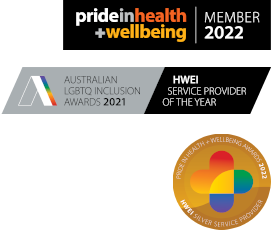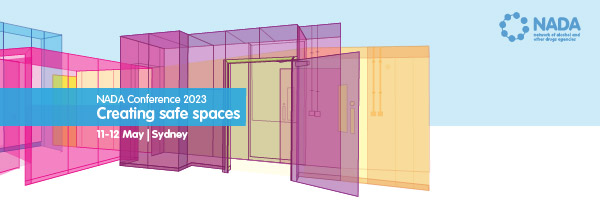NEWS
Abstracts are now open
NADA Conference 2023: Creating safe spaces
11–12 May
ICC Sydney Conference Centre
NADA invites abstract submissions for oral presentations, workshops, symposium and poster presentations for the NADA Conference 2023. This is an opportunity for you to showcase your innovative practice or research.
We encourage workers and services across all sectors to submit an abstract. Interactive and practice-focused sessions are encouraged to maximize opportunities for conference participants to exchange practice and experience.
Conference themes
Presentations may focus on any topic related to the conference theme, Creating Safe Spaces.
The theme aims to highlight sector achievement and innovation, with a focus on:
• worker wellbeing
• cultural safety
• consumer engagement and peer work
• connection and collaborative practice
• the strength of communities of practice
• increasing inclusion and equity.
NADA encourages presentation proposals from people who are working with or identify as part of communities (including but not limited to Aboriginal and Torres Strait Islander Peoples, culturally and linguistically diverse communities, gender and sexuality diverse communities, and individuals with lived experience). NADA also encourages all presentations to consider the needs and perspectives of these populations.
How to choose a topic for presentation
Abstracts should consider how their practice or research is relevant to the conference theme and goals, as well as the audience who will be attending the conference.
Attendees of the conference will include:
• frontline staff and managers in the AOD sector
• sectors working with clients with AOD issues
• researchers with an interest in community responses to AOD
• policy makers and funders
• clients, consumers and carers.
Abstract submission process
• Abstracts are welcome from all sectors across Australia and internationally.
• Abstracts must be submitted by Friday 3 February 2023.
• Your abstract must be submitted using an online form.
• Proposal notifications will be sent from mid-February 2023.
Conference attendance
Presenters are required to attend the conference and purchase a ticket and travel. NADA has a small number of transport and accommodation grants available. Applications for these grants will open early next year. Contact for more information.
Abstract writing support
NADA has partnered with the Matilda Centre to provide support to NADA members with the abstract submission process.
Watch this webinar to learn about the abstract writing and submission process, practical tips, and more
To access one-on-one support from the Matilda Centre, NADA members can email
Abstract enquiries
All enquiries should be sent to
NADA strongly encourages applicants to read the guidelines below before submitting their abstracts.
Guidelines
All abstracts must be written in complete sentences, not dot-pointed or in table format.
Oral paper: 20 minutes long, oral papers provide authors the opportunity to present original work related to conference topics.
Workshop: 30–40 minutes long, workshops provide authors the opportunity to present their work in a highly interactive manner that maximises audience participation. Workshops should have at least 25% of the total time allocated to questions and answers, or to group interaction. Workshops should facilitate and engage discussion with the participants.
Lightning round: 10 minutes long, lightning round presentations provide authors the opportunity to share their work in brief oral presentations. Each presentation is limited to ten minutes, with five minutes allocated for questions and answers.
Symposium: Symposium presentations provide an opportunity to present on one topic, from multiple standpoints. Symposia presentations comprise three related presentations and an opportunity for questions and discussion. Presentations should be 40 minutes in total for your prepared content and 20 minutes for questions and discussion.
Poster presentation: Poster presentations are an opportunity for you to present your work, yet the output is graphical/textual, not oral. It is not a poster to advertise or market your service, but to demonstrates the nature of your work, much like a conference presentation. The final poster will mostly rely on diagrams, charts and images rather than text. The maximum poster size is 850mm x 1100m and font used should be size 18 or larger.
Abstracts will be scored on the following points:
- innovation and originality,
- whether the project, research or policy has a practical application, and
- whether the abstract submitted clearly explains the outcomes of the project, research or policy and its implications for the sector.
NADA believes that language has the power to stigmatise and empower. The following resources provide best-practice guidelines on how to use language to reinforce person-centred approaches and avoid perpetuating harm.
Language matters Download this [PDF]
Aboriginal and Torres Strait Islander Peoples (Terminology) Download this [PDF]
ACON Trans and gender diverse-affirming language guide Download this [PDF]
PWDA Language Guide: A guide to language about disability Download this [PDF]
What is an abstract?
An abstract is a short paragraph that provides the reader with a summary of your presentation. It is what the selection committee will use to determine whether you will be chosen to present at the conference —think of it as an elevator pitch.
What should be included in an abstract?
An abstract should cover the following points concisely:
- • The primary aim of this project or research and why it was undertaken (one or two sentences, about 50 words). What problem were you attempting to solve?
- • The methods used in the research or the steps that were taken as part of the process, as well as the scope of the project (one or two sentences, about 50 words).
- • Results and key lessons learned. (About 75 words)
- • Implications —why do/should these results matter to the sector? (About 75 words)
Do’s and don’ts
Avoid: Providing a statement of what your presentation will explore without telling the audience what you found out (e.g., This report will examine the causes of higher levels of alcohol use).
Instead: State the conclusions of the study or project (e.g., This study found that higher levels of alcohol use are caused by the following factors.).
Avoid: Giving a general overview of the program you provide or your service.
Instead: Specifically address a lesson you have learned through service delivery or a particular best-practice example from within your program. Think about what you would want the audience to take away and how your submission is relevant to the conference theme.
Avoid: Speaking in generalities (e.g., This project found that there are ways to increase retention in mental health programs).
Instead: Use specific details (e.g., This project found that person-centred and trauma-informed care increased retention in mental health programs).
Avoid: Reference to past studies or potential future findings that are not covered in your abstract and presentation (e.g., As previous research has shown, vaping is on the rise in residential services).
Instead: Ensure that your abstract makes sense to the reader on its own, rather than relying on references to external sources. If you must refer to future research, specify clearly what you will do and when.
Avoid: Lengthy background or contextual information.
Instead: A short sentence outlining the problem you hoped to solve, or the context of your research, is sufficient.
Avoid: Redundant phrases, unnecessary adjectives and repeated information. (e.g., Experience of leading and managing programs and projects in the sector has been extensive and lengthy).
Instead: Keep sentences short and avoid using overly descriptive language.
Avoid: Using highly niche language or specific jargon, especially without explaining it first. (e.g., adults with FASD are much more likely to experience AUD)
Instead: If you must use jargon, explain it the first time it is used. (E.g., Adults with foetal alcohol spectrum disorder (FASD) are much more likely to experience alcohol use disorder (AUD)).
Top tips
- • Make sure each sentence is unique and contributes to the logical flow of your abstract.
- • Keep it simple and specific.
- • Edit with a clear head—edit separately for content and flow, and for grammatical errors and spelling mistakes.
- • Place your topic in its context and identify its relevance clearly.
- • Think about ways your presentation can provide new insight.
- • Ask a friend or colleague to read over your draft—fresh eyes always help.
We strongly encourage all submissions to consider ethical approaches to research and evaluation and refer you to consider the CMHDARN Research Ethics Matter Guidelines.
1. Conflict of interest
Any conflicts of interest due to funding or relationships with publications/professional bodies must be disclosed.
2. Academic integrity
Abstracts must be original work, though an abstract can still be submitted if your work has been or will be published in a scientific journal. If the work has already been published, this must be disclosed.
3. Permission for publication
Submitting an abstract indicates permission for the abstract to be published on the conference website and in the conference handbook.
Our other sites
Find us on
NADA proudly acknowledges the Gadigal people of the Eora Nation as the custodians of the land on which our office stands. We extend this acknowledgement to all Aboriginal and Torres Strait Islander people across Australia and pay our respects to Elders past, present and future.

NADA has award level accreditation under the Australian Services Excellence Standards (ASES) a quality framework certified by Quality Innovation and Performance (QIP).
NADA is a member of


